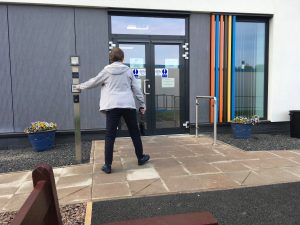It’s about the interaction, not the interface
How a trip to the hospital, and wait by a set of doors, prompted some thinking about interaction, context and empathy.
I recently had to visit a hospital. I happened to be sat in a place for about 30 minutes right by some doors. What happened there is a great example of why user experience is so much more than helping improve digital interfaces.
I commonly encounter an assumption around the University that what we do in the UX Service is a digital thing; a focus on user interfaces. Well, yes, there is an element of this but it really is the tip of the iceberg. Plus, who gets to decide what we consider an interface? They’re everywhere – not just in apps and websites. Certainly not just digital.
A stressful interface?
I’d left the hospital. It’s a lovely new development very recently opened in East Lothian outside Edinburgh. I was sitting in the sun near to the doors to the reception, waiting for my lift.
While sitting there, I noticed how people were approaching the doors into the building. Here’s what it looks like.
Sometimes the person or group walked up and did what was required. The noticed the post with the big ‘open door’ button on it and pressed it. The doors opened out towards them automatically, and they went in.
But a noticeable number didn’t do this. They walked up to the doors, tried to pull the handles, read the notices on the glass, even tried touching some of these notices seemingly trying to activate an opening mechanism. Once or twice I even intervened and pointed out what they needed to do because they were clearly flustered and couldn’t work it out.
Most of the time though, the people who missed the cue to operate the door opening controls either:
- comprehended the instructions on the door, took a step back and operated the button, or
- someone approached from the other side and opened the door for them as they were leaving.
Quantifying the experience
After about 10 minutes of this happening, I decided to make a log of what was going on.
Over the next 10 minutes, 14 individuals or groups of people approached the door. I’m going to exclude 3 groups who I’m pretty certain had prior experience because they were either badged NHS staff or uniformed delivery people.
Of the remaining 11 groups and individuals:
- 4 used the door controls as intended
- 2 approached the door and bypassed the controls but because someone was leaving the could enter without any interaction
- 3 read the notices on the door and corrected their behaviour accordingly without any notable issue. Within a few seconds they stepped back and pressed the button.
- 2 experienced more significant issues and were stood at the door for more than 10-15 seconds, reading all notices, trying the door handle and so on, before eventually identifying what they needed to do. One of these people was so self conscious about this experience that they spoke to me in a self-depreciating manner about the experience.
Only 36% used the doors as intended.
64% initially missed the controls to open the door.
Of these, 18% encountered significant problems.
A small sample, admittedly, but in terms of diagnosing usability issues, big enough I’d say.
We blame ourselves, almost instinctively
In my experience over the years of watching people interact with stuff, that’s what happens when someone spots their mistake or receives help with an interface. They blame themselves.
Imagine that – a door that makes you feel bad about yourself. Probably not something that the people designing the door entry interface considered to be an outcome of their work.
You might think, “So what? It’s a door, they got over it.”
But just think for a second about the context. How are people typically feeling when they visit a hospital?
What kind of environment does the hospital want to provide for their visitors?
Is this door control likely to be the only challenge during a visit? (It’s not, trust me).
This hospital – and indeed pretty much every hospital I’ve visited – is plastered in home-made posters providing extra guidance. Reminds me of a great meme I saw recently.

Tweet reads: Wherever there is a handmade sign, there’s usually a design problem. Notice on the speaker reads: ATTENTION! This is not a garbage can, it is a speaker. Do not throw trash inside!
Source: @TomGreever
So what’s this got to do with the University?
There are many different types of interface. Door mechanisms, signage, walk-up counters, phone dialogues; the list goes on. Digital interfaces have been growing ever more prevalent over the last 25 years but they’re unlikely to ever totally replace what came before. Similarly, we could begin to see them reduce as new points of interaction like voice interfaces come to the fore.
What won’t change is that we will continue to need to design interfaces.
And unless we change our approach we will continue to design them with a primary focus on the technology rather than the people who will use it. The user’s goals, and their context of use, have a huge bearing on how effective a design is likely to be.
Get in touch
Find out more about the kinds of work the UX Service is doing to help colleagues across the University deliver more useful and more usable services.




